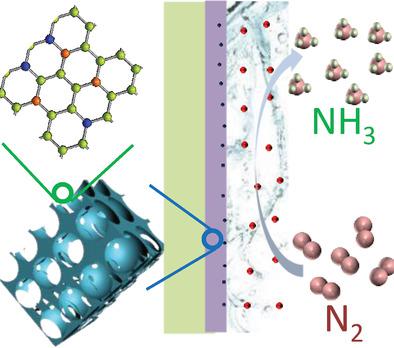Our official English website, www.x-mol.net, welcomes your
feedback! (Note: you will need to create a separate account there.)
Atomic Modulation, Structural Design, and Systematic Optimization for Efficient Electrochemical Nitrogen Reduction.
Advanced Science ( IF 14.3 ) Pub Date : 2020-01-19 , DOI: 10.1002/advs.201902390 Yiyin Huang 1 , Dickson D Babu 1 , Zhen Peng 1 , Yaobing Wang 1
Advanced Science ( IF 14.3 ) Pub Date : 2020-01-19 , DOI: 10.1002/advs.201902390 Yiyin Huang 1 , Dickson D Babu 1 , Zhen Peng 1 , Yaobing Wang 1
Affiliation

|
Ammonia (NH3) is a pivotal precursor in fertilizer production and a potential energy carrier. Currently, ammonia production worldwide relies on the traditional Haber-Bosch process, which consumes massive energy and has a large carbon footprint. Recently, electrochemical dinitrogen reduction to ammonia under ambient conditions has attracted considerable interest owing to its advantages of flexibility and environmental friendliness. However, the biggest challenge in dinitrogen electroreduction, i.e., the low efficiency and selectivity caused by poor specificity of electrocatalysts/electrolytic systems, still needs to be overcome. Although substantial progress has been made in recent years, acquiring most available electrocatalysts still relies on low efficiency trial-and-error methods. It is thus imperative to establish some critical guiding principles for nitrogen electroreduction toward a rational design and accelerated development of this field. Herein, a basic understanding of dinitrogen electroreduction processes and the inherent relationships between adsorbates and catalysts from fundamental theory are described, followed by an outline of the crucial principles for designing efficient electrocatalysts/electrocatalytic systems derived from a systematic evaluation of the latest significant achievements. Finally, the future research directions and prospects of this field are given, with a special emphasis on the opportunities available by following the guiding principles.
中文翻译:

高效电化学氮还原的原子调制、结构设计和系统优化。
氨 (NH3) 是化肥生产的关键前体,也是潜在的能源载体。目前,全球合成氨生产依赖于传统的哈伯-博世工艺,该工艺消耗大量能源并产生大量碳足迹。近年来,在环境条件下电化学二氮还原成氨因其灵活性和环境友好的优点而引起了人们的广泛关注。然而,二氮电还原的最大挑战,即电催化剂/电解系统特异性差导致的低效率和选择性仍需克服。尽管近年来取得了实质性进展,但获得大多数可用的电催化剂仍然依赖于低效率的试错方法。因此,有必要为氮电还原建立一些关键的指导原则,以合理设计并加速该领域的发展。本文从基础理论描述了对氮电还原过程的基本理解以及吸附物和催化剂之间的内在关系,然后概述了从对最新重大成就的系统评估中得出的设计高效电催化剂/电催化系统的关键原则。最后,给出了该领域未来的研究方向和前景,特别强调了遵循指导原则所带来的机会。
更新日期:2020-01-21
中文翻译:

高效电化学氮还原的原子调制、结构设计和系统优化。
氨 (NH3) 是化肥生产的关键前体,也是潜在的能源载体。目前,全球合成氨生产依赖于传统的哈伯-博世工艺,该工艺消耗大量能源并产生大量碳足迹。近年来,在环境条件下电化学二氮还原成氨因其灵活性和环境友好的优点而引起了人们的广泛关注。然而,二氮电还原的最大挑战,即电催化剂/电解系统特异性差导致的低效率和选择性仍需克服。尽管近年来取得了实质性进展,但获得大多数可用的电催化剂仍然依赖于低效率的试错方法。因此,有必要为氮电还原建立一些关键的指导原则,以合理设计并加速该领域的发展。本文从基础理论描述了对氮电还原过程的基本理解以及吸附物和催化剂之间的内在关系,然后概述了从对最新重大成就的系统评估中得出的设计高效电催化剂/电催化系统的关键原则。最后,给出了该领域未来的研究方向和前景,特别强调了遵循指导原则所带来的机会。











































 京公网安备 11010802027423号
京公网安备 11010802027423号